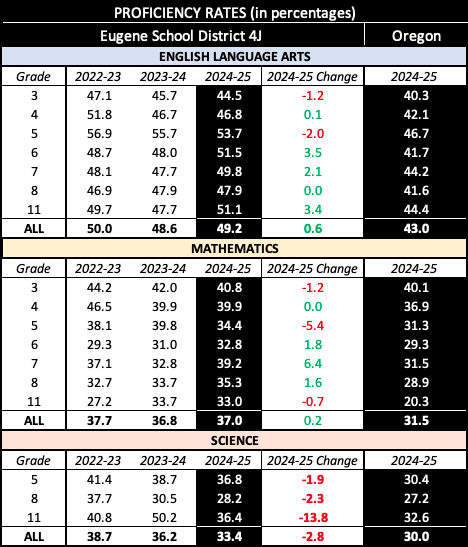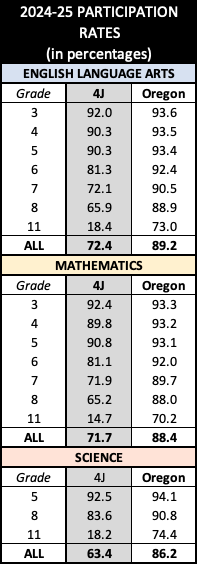State Test Results: ELA, Math Scores Inch Up
The percentage of 4J students proficient in English language arts and math for their grade level inched up slightly during the 2024–25 school year compared to the prior year, according to end-of-year state test results released by the Oregon Department of Education on Thursday, Oct. 2.
 Overall, 4J students whose results from spring testing met or exceeded the state standards rose 0.6 and 0.2 percentage points in ELA and math, respectively, compared to the 2023-24 school year, and decreased 2.8 points in science compared to the same period. Participation rates at 4J fell for ELA and math testing and remained unchanged in science. Our district continues to have test scores above the statewide averages but also participation rates well below the statewide average.
Overall, 4J students whose results from spring testing met or exceeded the state standards rose 0.6 and 0.2 percentage points in ELA and math, respectively, compared to the 2023-24 school year, and decreased 2.8 points in science compared to the same period. Participation rates at 4J fell for ELA and math testing and remained unchanged in science. Our district continues to have test scores above the statewide averages but also participation rates well below the statewide average.
Each spring, as required by the federal government, Oregon public schools test students in English language arts and math in grades 3–8 and 11, and science in grades 5, 8 and 11. The standards that serve as the testing benchmark identify the knowledge and skills that students should know or be able to accomplish to graduate high school and be prepared for college and career.
While the improvements in ELA and math proficiency are promising signs, as are 4J’s scores continuing to surpass the state’s average, the district acknowledges more work needs to be done to ensure that all students consistently reach proficiency across all subjects.
 Toward that end, 4J has adopted new, rigorous curriculum to help strengthen instruction and improve student outcomes: ELA in 2022–23, science in 2023–24, and math starting last year. Educators were deeply involved the comprehensive process to select the curriculum, which means they are on board with the higher expectations and more challenging material now being taught across the district. Because the curriculum is designed to build skills steadily from the earliest grades, the district expects to see benefits starting this year and improving over time, particularly for students who have had access from kindergarten. The new materials are also structured to support greater-than-average gains for student groups that have historically scored below the district average.
Toward that end, 4J has adopted new, rigorous curriculum to help strengthen instruction and improve student outcomes: ELA in 2022–23, science in 2023–24, and math starting last year. Educators were deeply involved the comprehensive process to select the curriculum, which means they are on board with the higher expectations and more challenging material now being taught across the district. Because the curriculum is designed to build skills steadily from the earliest grades, the district expects to see benefits starting this year and improving over time, particularly for students who have had access from kindergarten. The new materials are also structured to support greater-than-average gains for student groups that have historically scored below the district average.
End-of-year state tests are designed to identify differences in student group outcomes and help improve the education system over time. These tests do not measure the breadth of academic learning of any individual student, as they are limited to three academic subject areas. They do not identify all the strengths, talents, gifts, or needs of any individual. As well, they do not describe the full context of what a school is providing socially or academically to students.
One of the most significant challenges is participation in the year-end state testing. 4J has the lowest participation rate of Oregon’s ten largest districts, and the fourth-lowest of any district with more than 500 students. While state law allows families to opt out, a culture has developed—especially in the upper grades—where families choose not to have their students take the tests. This results in lower reported proficiency rates and limits the accuracy of the data, while also putting the district’s standing with state accountability requirements at risk. Superintendent Dr. Miriam Mickelson is committed to working with staff to better understand and explore options around state testing.
A change in how the state calculates proficiency rates for tests designed for students with the most significant cognitive disabilities resulted in slight increases in proficiency rates and slight decreases in participation rates.

 Additional settings for Safari Browser.
Additional settings for Safari Browser.


